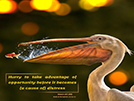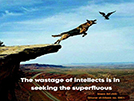Second Method: Experiment Beyond Sensation
- Details
- Hits: 2301
Second Method: Experiment Beyond Sensation
The second way of knowing God is by studying the signs of His presence and power in the world within us and around us. The Qur'Än has mentioned both these signs as follows:
“We shall show to them Our signs upon the horizons (i.e., space) and in their own selves so that it may become manifest to them that He is the Truth.” (41:53)
This method of knowing God is based on the principle of “cause” and “effect”. The signs of nature are the effects of which the ultimate cause is God.
Now, let us try to understand the nature and scope of this method more clearly.
* * *
Nature & Scope of this Method
Whenever we see a beautiful building of great splendour and design, we can easily understand that its architect was an expert in his own craft. Similarly, by looking at a car, an airplane, a computer or any other well-designed product or artifact, we are invariably guided to well-informed and knowledgeable inventors, designers and manufacturers, and we are also made aware of their skill and learning.
In none of these instances is it necessary to actually see the builder, the manufacturer or the designer of such an artifact with our own eyes to testify to his existence.
Moreover, when observing all these things, it is not with any of our external senses that we perceive the knowledge and skill of the builders and manufacturers. But, nevertheless, we believe in his expertise and knowledge. Why? Because the design and order which we perceived in the artifacts forces us to recognize the knowledge of their builders. And from this we reach the conclusion that it is not necessary that something whose existence we wish to believe in should be visible or tangible.
There are many things which are not perceptible to our external senses, but we become aware of them through their effects. For every wise person understands that there can be no effect without a cause, nothing orderly without a wise and knowledgeable designer.
Based on the above, we can divide the things of this world into two categories:
Things which are evident to one or more of the five senses; we observe visible things with the eyes, we hear sounds with the ears, we become aware of pleasant and unpleasant smells with our nose, we know bitter and sweet tastes with our tongue, and we feel hot and cold or rough and smooth with the skin of our body.
Things which are not perceived by any of the five senses, but whose existence we can deduce by considering their effects. These facts are not all of one kind, some are material and some are non-material. We shall mention a few of them here.
Electricity: By merely looking at two wires, one of which is electrified, we can never determine which of them has an electric current. We can only discover the existence of this current from the effect of electricity, e.g., a lamp being lit. So electricity is something which exists although our eyes cannot directly see it.
Gravity: If you let go of the book which you now have in your hand, it will fall to the ground, i.e., the ground will pull the book towards itself. This power is something which we do not directly perceive through our senses. Gravitation is again one of those things which is not visible, but we come to know its existence by observing its effect: the falling of bodies to the ground.
Magnetism: When we place a magnet beside a piece of iron, we do not see anything except the two objects. But when the iron is pulled towards the magnet, we discover that magnetism exists around the magnet.
Invisible Radiation: If we shine white sunlight through a prism we see on the other side of the crystal six colours (the spectrum) which are: red, orange, yellow, green, blue and violet. No more colours are to be seen on both extremes of the spectrum. However, scientists have discovered that in the place where the eyes see no more light, further `colours' exist which have heating and chemical properties. These `lights' are called infra-red and ultra-violet.
Intelligence & Mental Image: All of us are aware of ourselves, i.e., we perceive that we exist; and we also arrive at concepts in a gradual manner concerning matters outside ourselves which we explain by this kind of statement: “I solved the most difficult mathematical problem.” Also, man is aware of his own knowledge: he knows that he knows. Intelligence is not something visible or audible in the sense that man can see it with his eyes or hear it with his ears; but everyone finds it in himself. Others cannot learn about my intelligence through the five senses, but they can deduce its presence from the effect it produces. For example, when a scientist is expounding on a problem, it becomes clear that he has understood it.
People can construct in their own minds any form that they wish, e.g., a tower similar to the Eiffel Tower whose construction in the external world required many years, a thousand sorts of different building materials and substances, and hundreds of workers; this can be built in the mind in an instant. It is clear that others cannot be informed directly of the creations of our minds, because they are not visible and audible, but they can discover their existence from our speech.
Life: A beautiful chicken, moving towards the water, falls into a pond, and, before we can rescue it, it dies. At this very moment, what change has taken place in the chicken; and what difference has occurred that it no longer moves, plays or eats?
There surely was something in the live chicken but which does not exist in the dead—life itself. Life is not an object of the senses. We only perceive the effects of life: movement, feeding, etc., and from these effects we discover its existence.
* * *
The facts mentioned above make it thoroughly clear that over and above the beings that we perceive with our sensory organs, there are also things which we do not directly perceive, but we know about them only through the effects they produce.
Thus we draw the conclusion that it is not right for us to reject something which we do not see only because it is not visible, because invisibility is different from non-existence. Moreover, the way of discovering something is not confined to the eyes or other external senses. The human mind can discover something by means of the effects of those things, as we saw in the examples mentioned above.
We do not wish to say that God is similar to the scientific examples mentioned above, because God is a reality above those things, nothing is equal or comparable to Him. Our intention, however, is to say that in the same way as we discover the existence of those things through their effects, we can also discover the existence of God through His signs.
Discovering the existence of God through His signs is the "outer way" of knowing Him.
Thus, those who deny the existence of God just because they cannot see Him with their eyes, are blind as far as their eyes of wisdom and contemplation is concerned—since we know that His existence can be demonstrated through the precise design and order of creation. To these people we say, with the poet:
Open thy heart's eye for your soul to see,
And what is invisible will be manifest to thee.
* * *
This lesson is based on the followings:
Dar Rah-e Haq Board, The Roots of Religion, Qum 1982.
NÄsir MakÄrim Shirazi, Principles of Islamic Ideology, Tehran 1985.
Syed Saeed Akhtar Rizvi, Need of Religion, Tanzania 1970.
It has been compiled & edited for this course by S.M. Rizvi.











